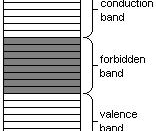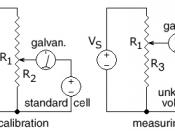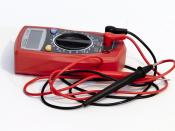Aim:
To investigate the resistance of different lengths of wire and to look for a correlation between the length of the wire and it's resistance.
Research:
Ohm is the common unit of electrical resistance, equivalent to one volt per ampere and represented by the capital Greek letter omega. The resistance of a wire is directly proportional to its length and inversely proportional to its cross-sectional area. Resistance also depends on the material of the conductor. The resistance of a conductor, or circuit element, generally increases with increasing temperature. When cooled to extremely low temperatures, some conductors have zero resistance.
The Greeks discovered electricity over 2000 years ago, and electrons were discovered by J.J Thompson in 1844.
Method:
I will test different lengths of wire by inserting it into the circuit shown below and record the readings of the ammeter in a table. I will then calculate the resistance by dividing the potential difference, which is the number of joules transferred per coulomb (measured in volts), by the current, coulombs per second (measured in amps) of the circuit to give me the resistance in ohms.
Resistance limits how easily an electric current can flow through a substance.
I will be using the same voltage throughout my experiment as the only variable which I wish to investigate is how the wire length affects the resistance. I will also be using the same type and thickness of wire. I will be changing the length of the wire and I will repeat my experiment three times using three different lengths of the same type and girth of wire so that I can work out an average set of results, which will be more reliable and accurate as any slight anomalies in the dimensions of the wire and freak extreme results will effect my...


